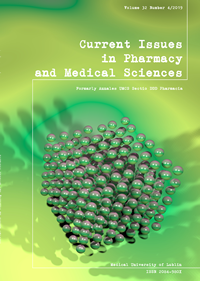The prevalence of selected genes involved in biofilm formationin Candida albicans isolated from the oral cavity
DOI:
https://doi.org/10.2478/cipms-2019-0031Słowa kluczowe:
biofilm, genomics, humans, oral cavity, yeastAbstrakt
Introduction. C. albicans genome sequencing enables investigation of the role of particular genes in biofilm formation involving the yeast-like fungi.
Aim. The aim of the study was to determine the genotypes of C. albicans isolates on the basis of the presence of the selected genes involved in biofilm formation.
Material and methods. The study material included C. albicans strains isolated from the oral cavity of 654 healthy individuals. The strain biofilm-forming capacity was estimated with the MTT assay and menadione. The presence of HWP1, ALS3, TUP1, NGR1, SAM2 and CYS3 genes was investigated.
Results. In total, 15 gene combinations were found, including nine gene combinations for strains with a confirmed biofilm-forming capacity, 11 – for the strains without this capacity, and five – independent of biofilm-forming capacity. A combination involving all the genes occurred in 72.5% of all biofilm-forming strains and in 53.8% of all strains that do not form biofilm. Moreover, the genetic material of 14.3% of all strains not involved in biofilm formation did not contain any of the studied genes. For one of the biofilm-species, no analyzed genes were found.
Conclusions.
- The absence of correlation between gene combinations HWP1, ALS3, TUP1, NGR1, SAM2 and CYS3 and biofilm-forming capacity of the studied C. albicans strains confirms the multigenetic – and not yet fully known – molecular basis of the formation of this structure. This result corresponds to the data reported by other researchers.
- Knowledge on the genetic foundations of biofilm formation is still developing and the list of biofilm-related genes has been considerably extended.
- The absence of correlation between the combinations of investigated genes and the biofilm-forming capacity of the studied C. albicans strains confirms a multigenetic, basis of this structure.
- The research on genes activated or inhibited during biofilm formation is extremely important, because it would enable the development of effective methods to disturb the biofilm forming process at the molecular level. There is a need for such methods in our clinical practice to prevent biofilm formation in the oral cavity.
Bibliografia
1. Finkel JS, Mitchell AP. Genetic control of Candida albicans biofilm development. Nat Rev Microbiol. 2011;9(2):109-18.
2. Nobile CJ, Mitchell AP. Genetics and genomics of Candida albicans biofilm formation. Cell Microbiol. 2006;8(9):1382-91.
3. Mnichowska-Polanowska M, Giedrys-Kalemba S. Methods and techniques used in Candida biofilm research (in Polish). Mikol Lek. 2009;16(4):238-42.
4. Li F, Svarovsky MJ, Karlsso AJ, et al. Eap1p, an adhesin that mediates Candida albicans biofilm formation in vitro and in vivo. Eucaryot Cell. 2007;6:931-9.
5. Mnichowska-Polanowska M, Kaczała M, Giedrys-Kalemba S. The characteristic of Candida biofilm (in Polish). Mikol. Lek. 2009;16(3):159-64.
6. Ahariz M, I Loeb, P Courtois. Oral candidiasis and dentures. Rev Stomatol Chir Maxillofac. 2010;111(2):74-8.
7. Blankenship J, Mitchell A. How to build a biofilm: a fungal perspective. Curr Opin Microbiol. 2006;9(6):588-94.
8. Karkowska-Kuleta J, Rapala-Kozik M, Kozik A. Fungi pathogenic to humans: molecular bases of virulence of Candida albicans, Cryptococcus neoformans and Aspergillus fumigatus. Acta Biochem Pol. 2009;56(2):211-24.
9. Kebaara B, Langford M, Navarathna D, et al. Candida albicans Tup1 involved in farnesol – mediated inhibition of filamentous-growth induction. Eukaryot Cell. 2008;7(6):980-7.
10. De Sordi L, Muhlschlegel F. Quorum sensing and fungal – bacterial interactions in Candida albicans: a communicative network regulating microbial coexistence and virulence. Yeast Res. 2009;9(7): 990-9.
11. Uppuluri P, Chaturvedi AK, Lopez-Ribot J. Design of simple model of Candida albicans biofilm formed under conditions of flow: development, architecture and drug resistance. Mycopathologia 2009;168(3):101-9.
12. Uppuluri P, Pierce C, Thomas D, et al. The transcriptional regulator Nrg1p controls Candida albicans biofilm formation and dispersion. Eukaryot Cell. 2010;9(10):1531-7.
13. Chandra J, Kuhn DM, Mukherjee PK, et al. Biofilm formation by the fungal pathogen Candida albicans: development, architecture, and drug resistance. J Bacteriol. 2001;183:5385-94.
14. Ten Cate JM, Klis FM, Pereira-Cenci T, Crielaard W. Molecular and cellular mechanisms lead to Candida biofilm formation. J Dent. Res. 2009;88(2):105-15.
15. Ene IV, Bennett RJ. Hwp1 and related adhesins contribute to both miting and biofilm formation in Candida albicans. Eukaryot Cell. 2009;12:1909-13.
16. Soll D. Why does Candida switch? Yeast Res. 2009;9(7):1-17.
17. Barnett JA. A history of research on yeasts 12: medical yeasts part I, Candida albicans. Yeast. 2008;25:385-417.
18. Wächtler B, Wilson D, Haedicke K, et al. From attachment to damage: defined genes of Candida albicans mediate adhesion, invasion and damage during interaction with oral epithelial cells. PLoS ONE. 2011;6(2). DOI: 10.1371/journal.pone.0017046.
Pobrania
Opublikowane
Numer
Dział
Licencja
Prawa autorskie (c) 2019 Autorzy

Praca jest udostępniana na licencji Creative Commons Attribution-NonCommercial-NoDerivatives 3.0 Unported License.


